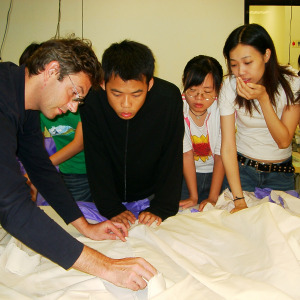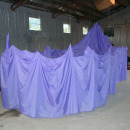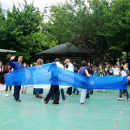Fabien Lerat 法比恩‧勒哈 @《城市與河流的交會—竹圍環境藝術節》

Fabien Lerat 法比恩‧勒哈 @《城市與河流的交會—竹圍環境藝術節》
法比恩‧勒哈
法比恩‧勒哈的作品對展覽而言是一幅風景畫。它是一個用布作成的橢圓形結構。離地數公分掛著,它好像在飄動。一旦進入它的內部,我們就可以發現我們被顏色包圍著 (本次展出作品共有兩件:淺紫色作品於竹圍工作室展出,深灰色作品於竹圍社區的寺廟展出)。75公分到220公分的不規則形狀將根據我們的位置,移動和大小,來包裝我們與自我改變。當我們穿梭其中,垂掛的布料因而改變造形,使其看起來像一座山。這個計畫是由藝術家站在海邊觀察而來。海水的律動,經過了數個世紀後,形成了小海灣,挖空了岩石,侵蝕了岩石的表面,磨亮了石頭。勒哈的作品展現了風景的接觸,成形,變形,和緩慢的運動。他的作品參考了中國水墨畫的歷史,因為水墨畫都是由山與水的元素所組成,而且沒有固定的觀點。他的作品探討人的軀體與感官的結合,這個作品反映出雙重的歷史:文化的歷史和場景的歷史。
Fabien Lerat
The works of Fabien Lerat were like a landscape in the exhibition. It's an oval structure constructed by cloth, hanging several centimeters above ground as if it were floating. Once inside we find ourselves surrounded by color (violet inside the Bamboo Curtain Studio, and dark grey for inside the temple in Chu-wei). The irregular shapes of 75 to 220 cm will be modified according to our position, movement, and size, to wrap us in. As soon as we move, the cloth will be transformed and can take the shape of a mountain. Once it happens, we feel the landscape and probably realize that we're by the water. The project came from the artist's seaside observation, after centuries of moving tides, the sea shapes the form of bays, hollows out rocks, polishes rocks. His works exhibits the contact, formation, deformation and slow movement of the landscape. At the same time, he took reference from historical Chinese paintings composed of water and mountains that do not take a solid form. His works favored the combination of human body and senses and reflected double history-cultural and site history.
Courtesy / 資料刊登允許:Bamboo Curtain Studio, Taiwan/ 竹圍工作室,臺灣






